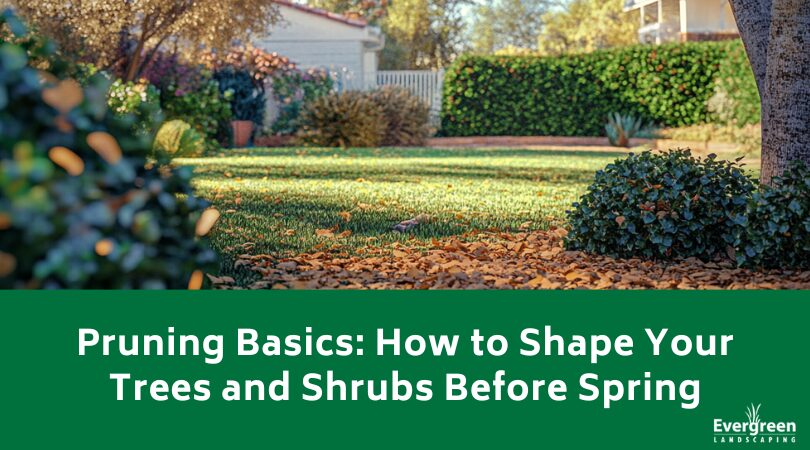Spring Pest Control Tips for Central Coast California Gardens

Spring is a time of renewal, bringing fresh growth, colorful blooms, and thriving gardens. Unfortunately, it also signals the return of many common pests looking for food and shelter. As temperatures rise, insects, rodents, and other pests become more active, posing a threat to plants and landscapes.
Central Coast California’s mild climate provides ideal conditions for many pests to flourish. With a combination of warm days, occasional rain, and abundant vegetation, spring gardens can quickly become a target for unwanted visitors. If left unmanaged, these pests can cause significant damage to plants, flowers, and even outdoor structures.
Taking a proactive approach to pest control can help protect your garden before infestations get out of hand. By understanding which pests are most common in the region and implementing simple prevention strategies, you can maintain a healthy, thriving landscape throughout the season.
Common Spring Pests in Central Coast Gardens
As the weather warms up, a variety of pests become more active, posing a threat to gardens and outdoor spaces. Some insects damage plants by feeding on leaves and stems, while others attract secondary pests or create nuisance infestations. Understanding the most common spring pests in Central Coast California can help homeowners take action before problems escalate.
Aphids
Aphids are small, soft-bodied insects that cluster on the undersides of leaves, feeding on plant sap. Their feeding weakens plants, leading to curled or yellowing leaves and stunted growth. In addition to direct damage, aphids excrete a sticky substance called honeydew, which encourages the growth of sooty mold. This mold can further stress plants and make them more vulnerable to disease.
Whiteflies
Whiteflies are tiny, winged insects that resemble small moths. Like aphids, they suck sap from plants, leading to leaf yellowing, curling, and general plant weakness. Whiteflies tend to target vegetables, ornamental plants, and fruit trees. Their rapid reproduction can make infestations difficult to control if left unchecked.
Slugs and Snails
Cooler spring temperatures and occasional rainfall create the perfect environment for slugs and snails. These pests chew irregular holes in leaves, stems, and flowers, causing significant damage to young plants and leafy greens. They are most active at night and hide in damp, shaded areas during the day. Without intervention, slugs and snails can quickly decimate tender new plant growth.
Ants
Ants may seem harmless, but in gardens, they can create a surprising amount of disruption. One of their biggest impacts is their tendency to protect and “farm” aphids, whiteflies, and scale insects. By defending these pests from predators, ants contribute to their population growth and plant damage. Certain species, like Argentine ants, are particularly aggressive and can invade homes in search of food and water.
Mosquitoes
Mosquitoes thrive in warm, damp conditions, and spring provides plenty of opportunities for them to breed. Standing water in plant saucers, birdbaths, clogged gutters, and even small puddles can serve as mosquito breeding grounds. Not only are mosquitoes a nuisance, but they can also carry diseases, making control an important part of outdoor pest management.
Rodents (Mice & Rats)
Rodents become more active in the spring as they seek out food sources in gardens and compost piles. Mice and rats can cause damage by gnawing on plants, fruits, vegetables, and irrigation lines. They also pose health risks by contaminating food sources and spreading disease. Keeping an eye out for burrows, droppings, or gnawed plant stems can help detect early signs of rodent activity.
Spring pests can quickly take over gardens if left unmanaged. Identifying and addressing infestations early is key to keeping plants and landscapes healthy throughout the season.
How to Prevent and Manage Spring Pests Naturally
Controlling garden pests doesn’t always require chemical solutions. Many natural methods can effectively reduce pest populations while keeping your garden safe for beneficial insects, pets, and the environment. By implementing a combination of these strategies, you can prevent infestations before they start and maintain a balanced ecosystem in your outdoor space.
Encourage Natural Predators
One of the most effective ways to control pests like aphids and whiteflies is to attract beneficial insects and wildlife that feed on them. Ladybugs, lacewings, and parasitic wasps help keep aphid populations under control, while birds eat a variety of insects, including caterpillars and mosquitoes.
To attract these natural predators:
- Plant nectar-rich flowers such as yarrow, dill, and alyssum to provide food for beneficial insects.
- Install bird feeders or birdbaths to encourage birds to visit your yard.
- Avoid broad-spectrum pesticides that harm both pests and their natural predators.
A well-balanced garden supports a healthy food chain, making it easier to control pests without intervention.
Use Physical Barriers
Some pests, like slugs and snails, require direct contact with plants to cause damage. Using physical barriers can keep them from reaching your vegetables, flowers, and ornamentals.
- Copper tape: Placing copper tape around raised garden beds or potted plants creates a mild electric charge that repels slugs and snails.
- Floating row covers: Lightweight fabric covers can protect young plants from aphids, whiteflies, and other flying pests while still allowing light and water to pass through.
- Diatomaceous earth: Sprinkling food-grade diatomaceous earth around plants acts as a natural deterrent for crawling insects like ants and earwigs.
By making it difficult for pests to access plants, you reduce the likelihood of infestations.
Remove Standing Water
Mosquitoes need water to reproduce, and even small amounts can serve as breeding grounds. Eliminating standing water is one of the simplest ways to reduce mosquito populations around your home.
- Empty plant saucers, birdbaths, and buckets at least once a week.
- Keep gutters clean and free of debris to prevent water from pooling.
- Use mosquito dunks (which contain natural bacteria toxic to mosquito larvae) in ponds or rain barrels to prevent larvae from developing into biting adults.
By making your yard less hospitable to mosquitoes, you can enjoy outdoor spaces without constant buzzing and bites.
Seal Entry Points
Rodents and ants often find their way into garden sheds, compost bins, and even homes in search of food and shelter. Blocking access points can help keep them out.
- Inspect outdoor structures for small openings, sealing any gaps with caulk or wire mesh.
- Store pet food, bird seed, and compost in tightly sealed containers.
- Trim trees and shrubs away from the house to remove easy access points for rodents and ants.
Taking a proactive approach to pest management through natural methods creates a healthier, more resilient garden while reducing the need for chemical treatments.
Organic and Eco-Friendly Pest Control Methods
For homeowners who want to manage garden pests without using harsh chemicals, organic and eco-friendly solutions offer an effective alternative. These methods not only help control infestations but also support a healthier garden ecosystem. By incorporating natural deterrents and beneficial planting techniques, you can keep pests at bay while maintaining a thriving outdoor space.
Neem Oil & Insecticidal Soap
Neem oil is a plant-based pesticide that works against aphids, whiteflies, and other soft-bodied insects. It disrupts their feeding and reproduction, making it an effective, non-toxic option for pest control. Insecticidal soap is another gentle yet powerful solution that coats pests and suffocates them without harming beneficial insects when used correctly.
To use:
- Apply neem oil or insecticidal soap in the early morning or late evening to avoid harming pollinators.
- Spray directly onto affected leaves, focusing on the undersides where pests tend to hide.
- Repeat applications as needed, especially after rain.
These treatments provide targeted control without introducing harmful chemicals into your garden.
Diatomaceous Earth
Diatomaceous earth (DE) is a fine, powdery substance made from fossilized algae. It works by damaging the exoskeletons of insects like ants, slugs, and earwigs, causing them to dehydrate and die. Since it is non-toxic to humans and pets, it’s a great choice for organic pest management.
How to apply:
- Lightly dust DE around the base of plants, creating a barrier that pests must cross.
- Reapply after heavy rain or watering to maintain effectiveness.
- Avoid inhaling the dust when spreading it—wearing a mask is recommended.
Diatomaceous earth is especially useful for protecting tender plants from crawling pests.
Homemade Traps
Simple, homemade traps can effectively reduce pest populations without the need for pesticides. Beer traps, for example, attract slugs and snails, while sticky traps work well for catching flying insects like whiteflies.
To create effective traps:
- Beer traps for slugs: Sink a shallow container into the soil and fill it with beer. Slugs are attracted to the yeast and will fall in. Empty and refill as needed.
- Sticky traps for whiteflies: Use yellow index cards coated with petroleum jelly to capture whiteflies and aphids. Hang them near affected plants.
These DIY solutions offer a cost-effective way to keep pests under control.
Mulching & Companion Planting
Mulching and companion planting are two natural strategies that discourage pests while improving soil health.
- Mulching helps prevent weeds, retains moisture, and can deter crawling pests. Cedar mulch, in particular, has natural pest-repelling properties.
- Companion planting pairs certain plants together to deter pests. For example:
- Marigolds repel aphids and nematodes.
- Basil helps keep mosquitoes and flies away.
- Lavender discourages moths and fleas while attracting pollinators.
By incorporating these organic methods, you can create a pest-resistant garden that thrives naturally without the need for synthetic pesticides.
When to Call a Professional
While many garden pests can be managed with natural and organic methods, some infestations require professional intervention. If pests are spreading rapidly, causing significant damage, or proving difficult to control with DIY solutions, bringing in an expert can save time and prevent further harm to your garden.
Signs You May Need Professional Help
Certain pest problems are too large or persistent to handle alone. You may need expert assistance if you notice:
- Widespread damage affecting multiple plants, trees, or sections of your yard.
- Recurring infestations despite using natural and organic control methods.
- Large colonies of pests, such as ant infestations inside and outside your home or rodents burrowing near garden beds.
- Structural damage from pests like termites or rodents gnawing through irrigation lines.
When infestations go beyond surface-level damage, professional treatment may be the best way to prevent long-term issues.
Safe and Targeted Pest Control
A major concern with chemical pest control is its impact on pollinators like bees and butterflies, as well as beneficial insects that naturally help manage pests. Professional pest control services can offer safer, more targeted solutions that:
- Minimize the use of broad-spectrum pesticides that harm beneficial insects.
- Use environmentally friendly methods designed to target specific pests without affecting surrounding plants and wildlife.
- Implement long-term prevention strategies instead of relying solely on chemical treatments.
Working with professionals who prioritize eco-friendly pest control ensures that your garden remains healthy and balanced.
How Landscaping Experts Can Help
Professional landscaping services go beyond pest removal—they help create a garden that naturally resists infestations. Experienced landscapers can:
- Recommend and install pest-resistant plants suited to Central Coast California’s climate.
- Improve soil health and drainage to reduce conditions that attract pests.
- Design a well-balanced landscape that encourages natural pest predators like birds and beneficial insects.
If your pest problem is persistent or overwhelming, reaching out to a professional can protect your garden and restore balance to your outdoor space.
What’s Next?
Spring pests can quickly take over a garden if left unchecked, but with the right prevention and management strategies, you can keep your outdoor space thriving. Encouraging natural predators, using physical barriers, and implementing organic pest control methods all play a role in maintaining a healthy, pest-resistant landscape.
Regular monitoring is key—pest populations can grow rapidly as temperatures rise. By staying proactive and addressing issues early, you can minimize damage and reduce the need for more intensive treatments later in the season.
Evergreen Landscaping offers expert advice and services to help protect your garden from spring pests. Contact us today for a consultation and let us help you create a pest-resistant outdoor space!
















